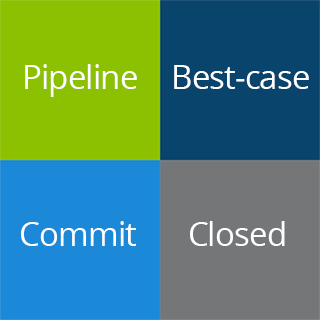Stop Asking Salespeople to Estimate Probabilities in Their Forecast Process!
- Generating a sales forecast requires four data points: opportunity amount, sales stage, closed date and forecast category
- When designing a forecast process, use a limited number of forecast categories
- To avoid confusion, just stick to widely recognized, standard categories: pipeline, best-case, commit and closed
Generating a sales forecast requires four data points: opportunity amount, sales stage, closed date and forecast category. Combine these four points with a rigorous and well-designed forecast process – plus insightful analytics – and forecast accuracy and sales accountability improve dramatically.
 When designing a forecast process, use a limited number of forecast categories and ensure that they are well-communicated and understood. Examples of overly complicated and poorly defined forecast categories include “blood commit,” “VP judge,” “committed commit” and “no, this-time-I-really-mean-it commit.” Okay, so I made that last one up, but you’d be surprised at the number of companies with more than four or five categories, many of which could be interpreted in multiple ways! To avoid confusion, just stick to widely recognized, standard categories: pipeline, best-case, commit and closed.
When designing a forecast process, use a limited number of forecast categories and ensure that they are well-communicated and understood. Examples of overly complicated and poorly defined forecast categories include “blood commit,” “VP judge,” “committed commit” and “no, this-time-I-really-mean-it commit.” Okay, so I made that last one up, but you’d be surprised at the number of companies with more than four or five categories, many of which could be interpreted in multiple ways! To avoid confusion, just stick to widely recognized, standard categories: pipeline, best-case, commit and closed.
- Pipeline refers to early stages of development. Except with very short sales cycles, there should be few pipeline opportunities dated in the current forecast period.
- Best-case means the sales process may complete by the close date, given an ideal set of circumstances that the seller documents and shares during forecast meetings.
- Commit means that, based on the seller’s best estimates, the sales process will complete by the close date reflected.
- Closed means the final order is processed (booked) or revenue is recognized.
Notice that I left “probability” off the list of data required to complete a forecast. The first reason is that forecast categories and probabilities conflict with each other, and this confuses everybody – including reps, sales leaders, sales operations and finance. To illustrate, take an opportunity with a 30 percent probability and a forecast category of commit. Which is correct: the 30 percent probability? The forecast category? Both?
If both are correct, then the opportunity, by definition, is best-case. Using conflicting fields of forecast category and probability creates a forecast process that requires individuals to send an email or pick up the phone to clarify what is meant by the information in the sales force automation platform (SFA). That defeats the purpose of having a SFA!
The second reason for not including probability in forecast data is that probabilities work best in a global sales funnel if it’s a large enough data set. They don’t work at the individual level (unless it’s a small- to medium business [SMB] and opportunity sizes fall within a tight range). In both instances, sales operations can calculate and apply probabilities to improve organizational forecast accuracy.
There’s no reason to ask sales to provide probability information on an opportunity-by-opportunity basis. If SMB reps find the information useful in planning required activities to meet their sales objectives, then sales operations can set default probabilities in the SFA for sales to see. They can even provide a dashboard with a factored forecast that suggests required activities and funnel thresholds.
For enterprise sales organizations with larger longer-term variable-sized deals, probabilities definitely don’t work below the CSO level. Why? Because the closure of a large enterprise deal is binary: Either it happens or it doesn’t. Try applying a 40 percent probability on a $1,000,000 deal and then have it not close. You’ll miss your forecast by at least $400,000.
So, sales operations, let’s just stop wasting reps’ time by asking them to estimate probabilities in addition to providing forecast categories. While we’re at it, there are a few other things we can do to give the sales team a few more selling hours per week. Let’s take all forecast processes out of Excel once and for all. Forecasting is more than a mathematical exercise. It’s a communications exercise, and over the years, there have been some incredible tools developed to facilitate a smooth process while providing the necessary analytics.
Finally, it’s time to stop asking, “do we need a predictive forecasting solution?” The answer is yes – yes, we do. Intuition is – and will always be – an important part of determining a commit, but predictive solutions now have the ability to calculate real probabilities using highly complex, completely objective, multivariate algorithms. They make our current primitive guesses and calculations look like chisel and stone by comparison!